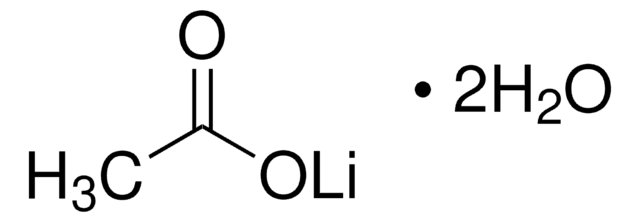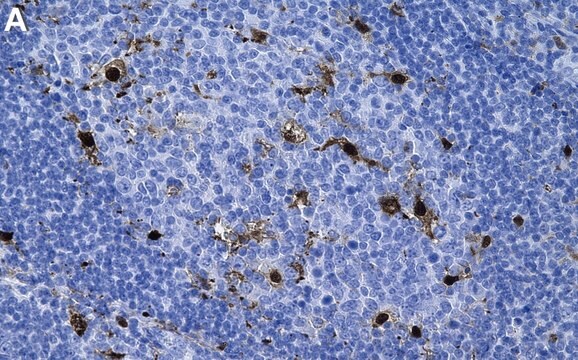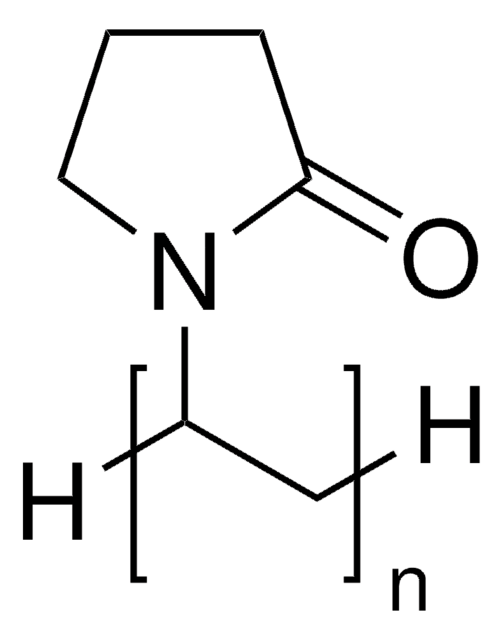추천 제품
유형
(High purity Salts)
Quality Level
분석
≥99.9% trace metals basis
양식
powder or crystals
solid
불순물
≤1000 ppm (trace metals analysis)
색상
white to off-white
pH
≤9.5
mp
53-56 °C (lit.)
solubility
water: soluble
음이온 미량물
chloride (Cl-): ≤20 ppm
sulfate (SO42-): ≤50 ppm
양이온 미량물
Al: <100 ppm
Cu: <100 ppm
Fe: <100 ppm
K: <100 ppm
Mg: <100 ppm
Na: ≤50 ppm
Pb: <100 ppm
Zn: <100 ppm
응용 분야
battery manufacturing
SMILES string
[Li+].[H]O[H].[H]O[H].CC([O-])=O
InChI
1S/C2H4O2.Li.2H2O/c1-2(3)4;;;/h1H3,(H,3,4);;2*1H2/q;+1;;/p-1
InChI key
IAQLJCYTGRMXMA-UHFFFAOYSA-M
유사한 제품을 찾으십니까? 방문 제품 비교 안내
일반 설명
Lithium acetate dihydrate is a soluble white compound with a one-dimensional structure. Lithium acetate dihydrate has various applications in industries such as pharmaceuticals, ceramics, and research laboratories. It is often utilized as a source of lithium ions in chemical reactions and as a precursor in the synthesis of other lithium compounds.
애플리케이션
Lithium acetate dihydrate is a significant salt with a wide range of applications. It is utilized as a component in drug formulation and therapy, as a buffer for DNA and RNA gel electrophoresis, and as an additive or catalyst in textiles and polymer production. Additionally, it serves as a ferromagnetic nanoparticle, catalyst, and precursor material for batteries
Our Lithium acetate dihydrate, with a purity of 99.9% on a trace metals basis, serves as an excellent precursor for batteries and catalysis. Its low trace metals content and anions make it particularly well-suited for these applications.
Our Lithium acetate dihydrate, with a purity of 99.9% on a trace metals basis, serves as an excellent precursor for batteries and catalysis. Its low trace metals content and anions make it particularly well-suited for these applications.
- Lithium Iron Pyrophosphate (LiFe1.5P2O7) with monoclinic structures was successfully synthesized using Lithium acetate dihydrate in combination with other metal acetates, in a ratio of Li/Fe/P = 1.05:1.5:2, through a wet-chemical method. Maintaining the appropriate lithium concentration is crucial to prevent stoichiometry loss in the final product. This material has found application as a positive electrode in Lithium-ion batteries. Remarkably, the electrode demonstrates excellent incremental capacity, indicating a stable structure during the initial cycle, with redox peaks observed at 3.33 and 3.22 V versus Li0/Li+
- LiMn2O4 films were synthesized on Au foil using the sol-gel and spin-coating techniques, employing Lithium acetate dihydrate and manganese acetate tetrahydrate in a Li/Mn ratio of 1.1/2. The particles used had an average size of approximately 300 nm. To investigate the morphological changes during over-discharging, the EC-HS-AFM technique was utilized. The images captured revealed the presence of wrinkle-like and step-like structures on the particle surface. These structures were attributed to stresses induced by structural distortion during the phase transformation from cubic (LiMn2O4) to tetragonal (Li2Mn2O4). The formation of the Li2Mn2O4 phase was confirmed through ex situ XRD analysis. Furthermore, by analyzing the EC-HS-AFM images, the particle surface area was quantitatively extracted as a function of potential, providing insights into the irreversible expansion/contraction behavior of the particles
- Cobalt-free cathodes, specifically Mg and Zr modified LiNi0.5Mn1.5O4 (LNMO), were synthesized using Lithium acetate dihydrate and other metal acetates via a citric acid sol-gel method. The modifications aimed to improve the electrochemical performance of the cathode, particularly at high temperatures, by limiting Mn dissolution and adjusting interstitial sites. This modification resulted in increased stability of the cathode, extending the cycle life to 1000 cycles at both 25 and 50 °C
특징 및 장점
- Water soluble
- Medium purity (99.9%)
- Low trace metals in ppm level
- Cost effective
- Low Chloride and sulfate levels
Storage Class Code
11 - Combustible Solids
WGK
WGK 1
Flash Point (°F)
Not applicable
Flash Point (°C)
Not applicable
가장 최신 버전 중 하나를 선택하세요:
자사의 과학자팀은 생명 과학, 재료 과학, 화학 합성, 크로마토그래피, 분석 및 기타 많은 영역을 포함한 모든 과학 분야에 경험이 있습니다..
고객지원팀으로 연락바랍니다.






